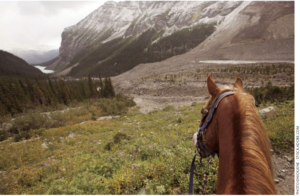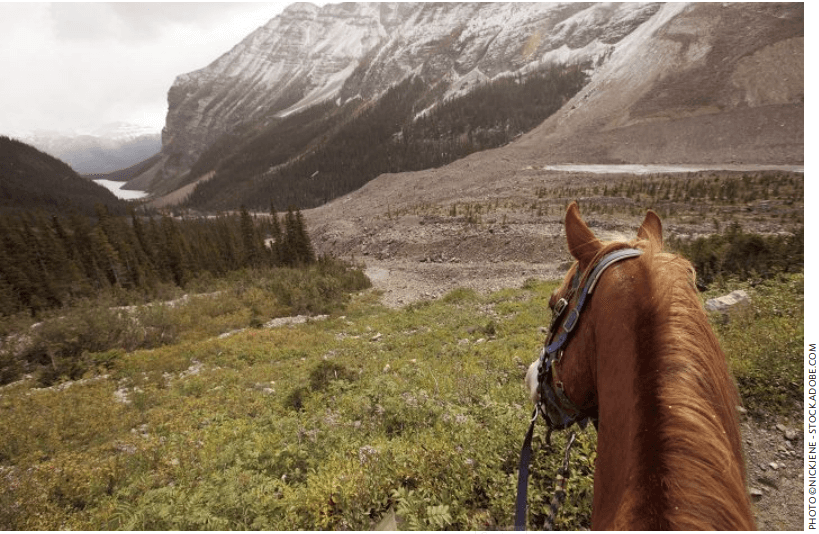Exercises and Practices to Take Control of Fear
By Robert Eversole

Greetings, I was originally going to write about low impact horse camping techniques for this month’s column. However, instead of that we’re going to talk about a topic that is more important and one that may just save your life.
If you ride a horse you’ve experienced fear. Whether in an arena or on the trails the potential for a problem is real. If we can learn to understand those fears and find ways to minimize the inherent danger of our equestrian activities, we’ll be much better riders, and also have a much better time on the trail. Anticipating the “what ifs” of an adventurous trail ride will help you to prepare for any eventualities that may occur during your outing.
If we stop to think about it one of the biggest fears that we as riders experience is the fear of falling. Falling is the potential outcome of any problem we encounter. By learning to control our fear of an unscheduled dismount, perhaps we’ll be able to enjoy more of our ride. It may be counterintuitive, but let’s spend a few minutes thinking about and visualizing how to perform an emergency dismount, and consider practicing this at home.
Once you’ve lost your seat so thoroughly that you’re going to come off it’s time to take control of your fall. There are four main parts to an emergency dismount.
- Kick your feet out of the stirrups and drop the reins, do not maintain a death grip on your mount. – The idea is to break all forms of attachment to the horse, you don’t want anything holding you to the horse; you want to be free and clear when you land. Don’t worry about the horse running loose; if you are in danger, then you must protect yourself first.
- Lean forward and use the horse’s neck to maintain some bit of control over your speed and direction as you dismount. As you’re coming off, use the horse’s neck to push against so that you land away from the horse and not underneath where you could be stepped on.
- As your feet hit the ground, try to stay upright. If you fall, tuck and roll away from the horse.
- In an emergency dismount, try to land on your feet. This is much safer than landing on your head, your hip, or trying to break your fall with your arms.
If you can perform these steps when you are in control, you are more likely to be able to do them when you lose your balance on the trail in the middle of the proverbial “train wreck”. Consider practicing an emergency dismount at home, in a safe setting with good footing for a practice fall at halt, to get the idea. Then try at walk. Once you feel comfortable doing an emergency dismount in a controlled situation, you may be much safer the next time you need it.
In addition to knowing emergency dismount techniques, here are a few more tips to help you battle the “fear factor,” whether you’re in the backcountry, the front country or anywhere in between.
Relax. Yes, this is much easier said than done. When you’re tense your riding suffers and it feels even more frightening. If you can get your body to relax it will help you feel more relaxed emotionally as well.
Breathe. When you’re tense, you unconsciously hold your breath. To start breathing regularly try talking or singing; when I get nervous and tense I often sing.
Balance. When you’re tense, you have a tendency to lean forward into a fetal position. Fight this by sitting up straight and deep in the saddle, putting your shoulders back (I tell my students to sit tall like a soldier).
And finally find something to focus on that’s positive. Think about what a great day it is and how much fun it is to ride with your favorite trail buddy.
As always, for more information on this and other topics, as well as the largest source of validated and free horse trail and horse camp information in the U.S. visit www.TrailMeister.com.
Published September 2011 Issue

Robert Eversole, ”the trail meister,” owns www.TrailMeister.com, the largest database of horse riding and camping areas in the U.S. with free trail and trailhead information, trail maps, and much more to help horse enthusiasts experience the joys of trail riding. Robert is a registered riding instructor with PATH International, a mounted search and rescue team member, and a U.S. Marine who has served on the board of the Backcountry Horsemen of Washington (BCHW). He is enjoying his new career helping fellow trail riders stay found and safe on the trail. When not on the trail, The Trail Meister resides near Spokane, WA and teaches land navigation to a wide variety of outdoor groups across the nation. For North America’s largest horse trail and camping directory, trail tips, and more, visit www.TrailMeister.com.

